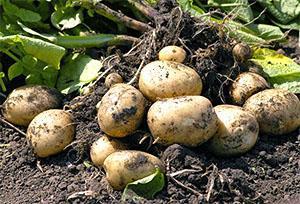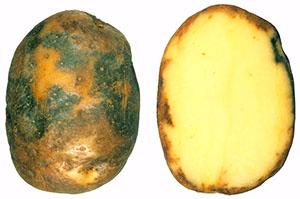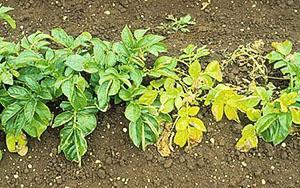All about potato diseases
 Cultivation of crops requires proper care for the future harvest. Potato diseases can cause serious damage if the necessary measures are not taken in time. What diseases do farmers face and how to deal with them?
Cultivation of crops requires proper care for the future harvest. Potato diseases can cause serious damage if the necessary measures are not taken in time. What diseases do farmers face and how to deal with them?
How to deal with late blight on potatoes? Causes of the disease

In the photo, late blight of potatoes - the pathogen acts to a greater extent on the tubers, but the disease also manifests itself on the tops. By its nature, the pathogen is a mushroom-like organism that is resistant to temperatures from 1 to 30 degrees. Spores get into the ground, after which they infect the tubers. Infection can occur during harvesting - spores from the ground are transferred to the tubers. Infection occurs through any mechanical damage. The best conditions for the development of spores are moisture.
 Why do potato leaves turn yellow? One of the reasons is precisely late blight. Visual manifestations - the appearance of brown spots on the leaves and stems. A cobweb-like coating may form on the back of the leaf. On tubers - brownish-brown necrosis spots. it disease it is almost impossible to cure if the focus has already developed, therefore the main control measures are prevention. (cm. recipe for potato pancakes with minced meat)
Why do potato leaves turn yellow? One of the reasons is precisely late blight. Visual manifestations - the appearance of brown spots on the leaves and stems. A cobweb-like coating may form on the back of the leaf. On tubers - brownish-brown necrosis spots. it disease it is almost impossible to cure if the focus has already developed, therefore the main control measures are prevention. (cm. recipe for potato pancakes with minced meat)
How to deal with late blight on potatoes? A number of measures have been developed to prevent and treat this disease:
 Before boarding:
Before boarding:
- The main thing is to remove the affected tubers from the seed material, which serve as the main source of disease for the entire future crop. Planting material must fully comply with all standards.
- It is important to choose the right place to grow your crop.
Please note: the landing site should not be in the lowlands, dry well after precipitation! Stagnant moisture contributes to the development of late blight:
- Consider planting sites for other crops - potatoes can be contaminated from tomatoes, which are also susceptible to this disease.
- If there are other people's gardens nearby, you should pay attention to the fact that there are no beds with tomatoes nearby.
- It is recommended to germinate the tubers before planting.
- Treatment with special preparations is of particular importance. Phytophthora "does not like" copper, therefore it develops best in soils that are poor in this chemical element.
- Fight against late blight during the growing season:
- It is recommended to treat the soil from possible infection and weeds. Don't wait for symptoms to appear - use a fungicide.
- Planting in high ridges reduces the chance of infection on the potato bush.
Preventive treatments do not make sense if the foci of the disease have already formed.
Treatment of potatoes from late blight should be carried out using chemicals 1-2 times a season. 2 weeks before harvesting, it is worth chemically removing the tops - this will protect the tubers from infection during harvesting.
- During and after cleaning:
- It is recommended to harvest no later than 14 days after the foliage dies.
If it rains during the period of dying off, moisture can contribute to the development of phytophthora - you need to harvest faster, but not during the rain.
- If the crop is wet for various reasons, provide good aeration so that the tubers are completely dry.
- Before placing the crop in storage, sort through it - it is necessary to identify and remove infected tubers.
Black scab: methods of disease prevention
 One of the most common diseases is black scab or rhizoctonia. This pathology has a surprisingly wide area of distribution. The causative agent is a fungus that causes the tubers to lose moisture. Signs of the disease appear at the stage of potato flowering. The development of pathology best occurs at a temperature of + 16 + 18 degrees, humidity - 70%. Unlike phytophthora, the level of harmfulness of scab depends on several factors:
One of the most common diseases is black scab or rhizoctonia. This pathology has a surprisingly wide area of distribution. The causative agent is a fungus that causes the tubers to lose moisture. Signs of the disease appear at the stage of potato flowering. The development of pathology best occurs at a temperature of + 16 + 18 degrees, humidity - 70%. Unlike phytophthora, the level of harmfulness of scab depends on several factors:
- the amount of fungus in the soil;
- the quality of the seed;
- type of planting - the density of the location of potato bushes;
- growing conditions for potatoes;
- type of soil - the infection develops best on loam;
- most importantly, the optimal level of soil acidity coincides with the ideal indicator for the development of potato tubers.
 The scab affects all parts of the bush and tubers:
The scab affects all parts of the bush and tubers:
- On tubers, scab appears as spots, net necrosis, which develops in hot weather. Depressions and pits are formed in conditions of excess moisture.
- Rot may form on the seedlings - the effect of "rotten wood".
- The stem of a diseased plant may be significantly lower than the rest.
- In humid and warm weather, a "white leg" of the stem forms.
In some cases, damage to seedlings is possible, due to which the bush dies even before it reaches the soil surface. The level of harm of the disease: from 10 to 40% of the crop dies, on an industrial scale - scab significantly worsens the presentation.
Potato diseases and the fight against them require drastic measures - first of all, preventive ones. It is worth considering not only how and how to cultivate the soil, but also where to plant potatoes.
- It is best to plant potatoes in the place where they previously grew: flax, rye, rapeseed, corn, perennial cereals.
It is not recommended to plant after cabbage, beets, pumpkins, tomatoes, clovers. These crops contribute to the development of black scab. Crop rotation planning - the main agrotechnical measure to combat the disease. Modern developments have made it possible to develop varieties that are resistant to disease.
- It is recommended to use chemicals - treat with fungicide. Chemical control is considered to be the most beneficial and effective method. You can process both seed and soil.
There are many types of scab, but the methods for dealing with it are similar.
Potato L-virus: control methods
 Why do potato leaves curl? The reason for this phenomenon may be the Leaf Roll Virus, which is capable of destroying 20 to 70% of the potato crop. Diseases of aphids that carry pathogens are transmitted. Wet weather contributes to the development of the disease. Symptoms are:
Why do potato leaves curl? The reason for this phenomenon may be the Leaf Roll Virus, which is capable of destroying 20 to 70% of the potato crop. Diseases of aphids that carry pathogens are transmitted. Wet weather contributes to the development of the disease. Symptoms are:
- The tops brighten, and the upper leaves of the bush curl.
- The leaves become brittle and rustle violently.
- The back of the leaf becomes white-silver.
Disease control requires the complete removal of infected potatoes from the seed and harvested crop, as the infection persists in the tubers. The main preventive measures are the treatment of the soil and potato bushes with aphids, which carry the infection.
Ring rot: symptoms and methods of struggle
 A common disease that affects all parts of the plant. The most common signs of the presence of the disease are wilting of the tops and rotting of the inner part of the tuber. Visual signs can be seen during the growing season of the plant. The development of the disease deprives the stem of the ability to receive moisture, which is why wilting is observed.
A common disease that affects all parts of the plant. The most common signs of the presence of the disease are wilting of the tops and rotting of the inner part of the tuber. Visual signs can be seen during the growing season of the plant. The development of the disease deprives the stem of the ability to receive moisture, which is why wilting is observed.
It is easy to infect a healthy plant or tubers. The pathogen easily overwinters in infected potatoes, and you can infect the seed while cutting the tuber with a knife. It is difficult to visually distinguish an affected potato from a healthy one, especially if the pathology is underdeveloped - it is enough to cut the tuber to see yellowing along the ring and the formation of extensive rot.
Control methods:
- Compliance with all the rules of crop rotation.
- It is necessary to remove the tops on time.
- Before planting, it is necessary to dry the seed material - for 2 weeks at a temperature not lower than +15 degrees.
- After drying, it is necessary to identify the affected material.
Various potato diseases (photo), the description and treatment of which is described above, require timely prevention.
a plot of 6 acres: minus parking, minus a house (6 * 6), minus paths, household buildings, "it is not recommended to plant potatoes after cabbage, beets, pumpkins, tomatoes" ... ... the author is really not of this world ((((((
potato tops are high, leaf is small, terry, green, does not bloom. What is this disease, is it dangerous for healthy potatoes. How to deal with it.
Perhaps the potato is sick with one of the types of mosaics, but it is impossible to say for sure without a photo. From affected bushes, the yield will be much less. It is necessary to dig up the affected bushes so that the infection does not go further. Burn the tops. You can eat tubers. Treat the area with a fungicide and do not dig potatoes for at least 10 days. Change the planting material for the next year. In the fall, sow mustard on the site of the dug out potatoes as a green manure for cleaning the soil.
Hello! I very much ask the Experts to answer me and, I think, many summer residents to the following question: What are the consequences of planting vernalized potatoes in insufficiently heated soil? It often happens that there are assistants for planting, but the ground has not warmed up to 8-10 degrees, and when it warms up, there will be no helpers. I am waiting for an answer very urgently, the assistants will come in 3 days. Thank you in advance for your answer or tell me where to find it? Best regards, Gennady. mountains. Pskov.
Potatoes planted in cold soil will wait for their time and only then will sprout. when the earth warms up. In the ground, it will not freeze. So feel free to give your assistants an outfit.
Good day. Tell me what it means to chemically remove the tops. Thank.
Burn it. This is the only way to destroy fungal diseases of any plant and prevent the spread of diseases. The tops of diseased potatoes are harvested and burned.
please help to save the potato crop !!! It is wet around the stems, and then (in the photo I dug a little) the bush falls apart, breaks and disappears .. I'm really looking forward to your advice !!!
Potatoes are affected by late blight. From folk remedies against diseases, iodine solution works well. There are 2 options. 1.30 drops of iodine + 1 cup of milk per 10 liters of water. 2.30 drops of iodine + 1 tbsp. l hydrogen peroxide per 10 l of water. Carry out thorough processing in the evening or in the morning, when there are no scorching rays of the sun. Dig up heavily affected bushes, and burn the tops. You will need at least 3 treatments every other day. Chemicals can be used, but potatoes cannot be dug after that for at least 10 days.
and I found such a bush ... is it contagious? and what would you advise?
please tell me why such bushes are obtained ?? is it contagious and what to do about it ??
Why do the leaves of potato bushes curl?
Potatoes are affected by late blight.
For the first time in 35 years of gardening, such a disease appeared on potatoes! What to do?
There are similar questions and answers to them in the comments. Potatoes are affected by late blight. The planting site in the fall must be carefully treated with fungicides. Re-process in the fall, apply fertilizers. The seed material of the potatoes will have to be changed.
The environment needs to be improved
ADDITION.
Potatoes are planted alongside a glass greenhouse next to corn.
Please answer my question.
The leaves are curled, wrinkled, the diseased bushes were removed, the rest was treated with a homom, but the infection process continues. And this is not the first year. The earth is clay.
Your site has contaminated soil. In the fall, it is necessary to cultivate the soil and apply fertilizers. in the spring, before planting vegetables, carry out another treatment two weeks before. In addition, it is necessary to update the planting material.
What's with the potatoes? Illness or other reason?
Deformation of potato tubers occurs if there was a sharp change in weather conditions during the growing season. Such root vegetables are not yet sick during harvest, but during storage they will rot first, since they contain less starch. So try to use them first.
But as for the spots on the potatoes, they are very similar to such a disease as common scab. She is very fond of just varieties with a red peel.
Hello. Help me determine what my potato is sick with. And how to treat.
Give a photo.
Hello! Potatoes have risen, two or three bushes of very light color. What could be? Thank.
The leaves began to wither on the potato. I dug a bush, and there the stalk was rotten. Inside one stem was a white caterpillar. For 2 weeks 6 bushes withered. What could it be?
I don't know what's wrong with the caterpillar, but potatoes have root rot. You probably water too much, which is why the rot has begun.
Just about today in my dacha I found such stems, there are no larvae in the stem. I threw out a lot of potato branches. We are all in frustration. We will probably stay without potatoes. This is after heavy rains, and now the heat has gone still phytophthora. Probably nothing do yes?
During storage, it turned out that seemingly healthy tubers, inside, seemed to have sprouted with black threads in a circle about three mm from the peel. But not rotten. What could it be? How to fight?
This is rust or glandular spot. Agronomists claim that such rings inside the potato indicate an excess of iron or a lack of phosphorus in the soil. My opinion is somewhat different and is based on personal experience. I decided to plant a new variety of potatoes and bought planting material. I really liked the appearance of the tubers and I decided to boil a few potatoes to make sure I made the right choice. When cleaning, I saw this problem. There was a lot of waste, but something remained for food. She planted it in the hope of getting healthy material. In autumn there was a complete disappointment. The new crop is also ringed. Conclusion - the disease from the infected planting material was transmitted to the new crop despite the change of the planting site. There is no point in planting such potatoes next year.